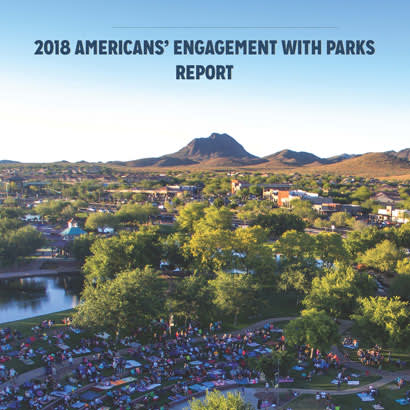
And are willing to pay for it
Everyone living in the United States should have easy access to great park and recreation opportunities. Easy access includes having a park, open space, recreation center or other recreation facility nearby to and from which they can travel safely. Our most vibrant and dynamic communities are those where residents can easily access well-maintained park and recreation amenities in just a few minutes without having to cross heavily traveled roads or navigate some other pedestrian hazard.
This year’s Americans’ Engagement with Parks Report explores the importance of having high-quality park and recreation amenities located nearby to all people, regardless of where they live. This survey is NRPA’s annual study that measures the general public’s strong passion for public parks. We first presented the findings from the 2018 study at this year’s NRPA Annual Conference in Indianapolis.
The good news is that the 2018 survey results show that most Americans do live near a park or other recreational opportunity. Three in 4 Americans indicate that there is at least one local park, playground, open space or recreation center within a 10-minute walking distance of their homes. However, the percentage of survey respondents living near a park or other recreational opportunity can vary significantly. For example, Americans are more likely to report a nearby park if they identify as Hispanic (84 percent) or non-white (83 percent). Furthermore, millennials (82 percent) and Gen Xers (79 percent) are significantly more likely to report having a park and/or recreation facility that is within walking distance than are baby boomers (65 percent).
Unfortunately, not everyone lives near a public park. Moreover, even for those who do, nearby parks are not always well-maintained or meet the specific needs and desires of the surrounding communities. Closing this gap is one of the reasons the National Recreation and Park Association, The Trust for Public Land and the Urban Land Institute launched the 10-Minute Walk Campaign. The goal of this program is to ensure every person in every community across the United States lives within a 10-minute walking distance of a great park. Through a collective national voice, mayoral endorsements and local community action, the 10-Minute Walk Campaign aims to increase park quality, park funding and park access within a 10-minute walk of everyone’s home.
Americans strongly support the goals of the 10-Minute Walk Campaign and want their local communities to participate in the program. Eighty-seven percent of survey respondents indicate they would support their communities’ participation in the 10-Minute Walk Campaign, with nearly 7 out of 10 strongly supporting the initiative. Indeed, backing for the campaign is solid across nearly every segment of the U.S. population — including those across the political spectrum — with particularly robust support from:
- Millennials
- Gen Xers
- Parents of children under the age of 18
And, Americans are willing to put their money where their mouth is. An overwhelming majority of survey respondents are in favor of local governments increasing financial support for public park and recreation services, particularly if it helps ensure all residents in their community can easily access a great park. Seventy-eight percent indicate they want their local governments to increase park and recreation spending from the current median monthly spending level of just under $7.00 per resident. Among that share, 31 percent would “definitely” support increased spending while another 46 percent would “probably” support it. The typical hike suggested by survey respondents would put median spending levels at $8.00 per resident each month, or a 22 percent increase from current typical spending levels.
Large majorities of Americans across all demographic segments support greater funding for local parks and recreation:
- Generation: Millennials (83 percent), Gen Xers (82 percent) and baby boomers (71 percent) Household formation: Parents (85 percent) and non-parents (75 percent)
- Political affiliation: Democrats (85 percent) and Republicans (73 percent)
- Where they live: Near a park (81 percent) and not near a park (67 percent)
- Household income: Respondents with income less than $35,000 per year (68 percent) and those earning more than $75,000 (82 percent)
Local political leaders, who make parks and recreation a cornerstone of their agendas, are likely to be rewarded at the ballot box. Seventy-six percent of Americans are more likely to vote for a local politician — a mayor, county executive or a member of the local council — if that politician makes park and recreation funding a priority. More so, a huge 92 percent of survey respondents who support the 10-Minute Walk Campaign are also more likely to vote for a local politician who makes park and recreation funding a key priority. It is noteworthy that Americans’ desire that local politicians support park and recreation funding is solid across nearly every segment of the population:
- Generation: Millennials (73 percent), Gen Xers (76 percent) and baby boomers (76 percent)
- Household formation: Parents (80 percent) and non-parents (73 percent)
- Political affiliation: Democrats (81 percent) and Republicans (76 percent)
- Where they live: Near a park (78 percent) and not near a park (69 percent)
- Household income: Respondents with income less than $35,000 per year (76 percent) and those earning more than $75,000 (79 percent)
The 2018 Americans’ Engagement with Parks Report results demonstrate that the mission of the 10-Minute Walk Campaign enjoys solid support among members of the public, who are willing to support increased taxes to ensure all people have easy access to a great park. These findings are consistent with the broader themes of the survey, which find Americans of all stripes agree parks and recreation is an important local government service. This is further demonstrated by the fact that 85 percent of Americans seek high-quality park and recreation amenities when they are choosing a new place to live. Hence, they want what is available to them to be available to all Americans. What a compelling message to share with our political leaders.
Kevin Roth, Ph.D., is NRPA’s Vice President of Professional Development, Research and Technology.

